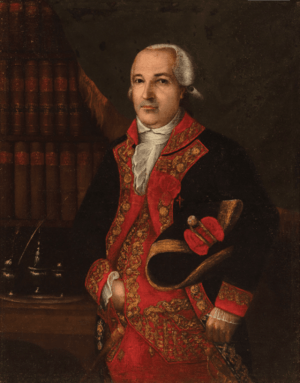Sebastián Calvo de la Puerta facts for kids
Quick facts for kids
Sebastián Calvo de la Puerta y O'Farrill
|
|
|---|---|

Portrait of an Important Spanish Colonial Official, likely Sebastian Nicolas Calvo de la Puerta y O'Farrill, Marquess de Casa Calvo, by José Francisco Xavier de Salazar y Mendoza (c. 1800)
|
|
| 10th Governor of Spanish Louisiana | |
| In office 1799–1801 Serving with Nicolás María Vidal
|
|
| Monarch | Charles IV |
| Preceded by | Francisco Bouligny |
| Succeeded by | Juan Manuel de Salcedo |
| Personal details | |
| Born |
Sebastián Nicolás Calvo de la Puerta y O'Farrill
August 11, 1751 Artemisa, Cuba |
| Died | May 27, 1820 (aged 68) Paris, France |
| Spouse |
Louisa Peñelvar y Navarette
(m. 1781; died 1792) |
| Military service | |
| Allegiance | |
| Branch/service | Spanish Army |
| Battles/wars | Louisiana Rebellion American Revolutionary War Peninsular War |
| Awards | Order of Santiago |
Sebastián Nicolás de Bari Calvo de la Puerta y O'Farrill (born August 1751 – died May 27, 1820) was an important Spanish nobleman and soldier. He was also known as the 1st Marquess of Casa Calvo. He served as the Governor of Louisiana for Spain from 1799 to 1801.
Contents
Early Life and Military Career
Sebastián Calvo de la Puerta y O'Farrill was born in Artemisa, Cuba. This was around 1751, though some sources say 1754. His parents were Pedro Calvo de la Puerta and Catalina O'Farrill.
He started his military career at a young age. In 1763, he joined the Company of Nobles as a cadet. This was a special training group for young men from noble families.
First Time in Louisiana
Casa Calvo first came to Louisiana in 1769. He was part of Alejandro O'Reilly's military group. Later, he served under Bernardo de Gálvez in 1780. This was during the American Revolutionary War, when Spain fought against Great Britain. He helped in the Mobile campaign.
In 1786, he received a special honor. King Charles III made him a nobleman. He was given the title of Marqués de Casa Calvo. He also became a knight in the Order of Santiago. This was a very old and respected Spanish order.
Service in the Caribbean
In 1794, Casa Calvo took part in another battle. He helped capture Fort-Dauphin in Saint-Domingue (now Haiti). This was during the Haitian Revolution, when the French colony was fighting for independence. He was in charge of the Spanish soldiers there.
He later became governor of Bayajá. He led army operations against the French Republic in Santo Domingo. However, the colony was later given back to France. This happened as part of the Peace of Basel agreement.
While living in Cuba, he got married. His wife was María Luisa Peñelvar y Navarette. She was from Havana, and they married in 1781.
Governor of Spanish Louisiana
In 1799, the governor of Louisiana, Manuel Gayoso de Lemos, died. At that time, Casa Calvo was in Cuba. He was working as a judge for the military.
Casa Calvo was then chosen to be the temporary military governor of Louisiana. He held this role until the new governor, Juan Manuel de Salcedo, could arrive. Salcedo's arrival was delayed because he was not well. He finally arrived in 1801.
In 1803, Spain returned Louisiana to France. Casa Calvo was there to help with this change. This made him special. He was the only Spanish governor of Louisiana who was present at both the start and the end of Spanish rule.
Later Life and Travels
Before Spain gave Louisiana back to France, France had promised to keep it from the United States. But France had already secretly sold it to the United States. This deal is known as the Louisiana Purchase.
Casa Calvo stayed in Louisiana even after it became American territory. His official reason was to help figure out the western border with Texas. During this time, James Wilkinson, who was the governor of the Louisiana Territory, tried to get information from Casa Calvo. Wilkinson wanted to help Spain in the border talks.
However, William C. C. Claiborne, the governor of the Territory of Orleans, did not trust Casa Calvo. In 1806, Claiborne ordered Casa Calvo to leave Louisiana.
Casa Calvo then traveled to Pensacola. He almost had a shipwreck on the way. He asked for permission to lead a military trip against Louisiana. But his request was not approved. He then moved to Madrid, the capital of Spain.
He was a strong supporter of Joseph Bonaparte. Joseph Bonaparte was the brother of Napoleon Bonaparte. He ruled Spain for a short time. After Joseph Bonaparte's rule ended in Spain, Casa Calvo had to leave. He went to Paris, France, where he lived until he died in 1820. He is buried in Père Lachaise Cemetery.
Images for kids
See also
 In Spanish: Sebastián Calvo de la Puerta y O%27Farrill para niños
In Spanish: Sebastián Calvo de la Puerta y O%27Farrill para niños


